Posted by Elena del Valle on October 31, 2018
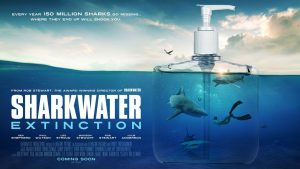
Sharkwater Extinction poster – click to enlarge
Video, photo: Courtesy of the Fort Lauderdale Int’l Film Festival (FLiFF)
Filmmaker Rob Stewart shines a light on the killing of sharks across borders in his third, and final, film Sharkwater Extinction. According to the film, worldwide between 100 and 150 million sharks, including endangered species and babies, are slaughtered for their flesh and fins every year, although only about half of them are reported. The Florida premier of the film will be at the Fort Lauderdale Int’l Film Festival (FLiFF) at 8 p.m. Saturday, November 17, 2018 at Bailey Hall, 3501 Davie Road, Davie, Florida (on the Broward College campus). Scroll down to watch a trailer.
In the documentary Stewart and other shark advocates travel to the often violent underworld of the pirate fishing trade in Florida and California as well as West Africa, Spain, Panama, Costa Rica and France. While in Florida they purchase various products at a grocery store and take them to Florida International University for testing. The scientists discover shark DNA in a number of them, including food, health and beauty products, fertilizer and pet food. In addition to beautiful underwater filmography with sharks the film features interviews with shark advocates, experts and locals as well as shaky undercover video.
In his first film, Sharkwater, Stewart brought attention to shark finning for use in shark fin soup. According to promotional materials, his multi award-winning film changed laws and public policy worldwide, and launched hundreds of conservation groups; more than 90 countries have banned shark finning or the trade of shark products.
Despite that unscrupulous fishermen fish sharks and equally unscrupulous buyers purchase them to make soups and much more so that, according to Stewart, they are still being fished to extinction. Stewart perished in a diving accident in the Florida Keys in January 2017 during the making of Sharkwater Extinction.
Posted by Elena del Valle on August 2, 2018

Theatrical one-sheet for Generation Wealth – click to enlarge
Photo, video: Lauren Greenfield, Amazon Studios
After 25 years as a photographer and filmmaker Lauren Greenfield became convinced that there was a theme to much of what she had observed. She felt a culture of wealth bound many of the images. She mounted a photographic exhibit of her work, published a book and released Generation Wealth, a 106-minute introspective film released via Amazon Studios. Scroll down to watch the film trailer.
The director and her family appear prominently in the film. She interviews them as well as people she knew in her high school years and the subjects of previous films and photography projects.
Questions about the film submitted via email to a representative remain unanswered as of this writing. The film was written by Greenfield who was also a producer. Frank Evers and Wallis Annenberg were also producers. Theater locations and additional information are available on the film website, generationwealthmovie.com
Greenfield is an Emmy-award-winning photographer, filmmaker, and chronicler of youth culture, gender, and consumerism. Other films by Greenfield include Queen of Versailles and Thin. The film was supported by a grant from the Sundance Institute Documentary Film Program with support from JustFilms and Ford Foundation Cinereach Project at Sundance Institute.
Posted by Elena del Valle on June 27, 2018
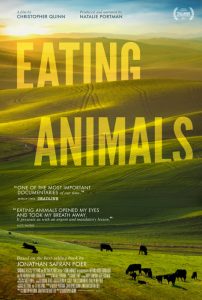
Eating Animals – click to enlarge
Photo, video: Courtesy of Sundance Selects. A Sundance Selects release.
Ever wonder where you eggs, dairy and meat come from? The makers of Eating Animals, a 94-minute film based on a book of the same title by Jonathan Safran Foer, went in search of answers. Over five years they visited farms, spoke with farmers, professors, industry experts, activists, and whistle blowers. They filmed in California, Nebraska, Iowa, North Carolina, China, Germany, India and Sweden. They imply that the factory farming practices of recent decades have degraded our humanity by making us part of the inhumane treatment of animals, polluted our environment and put our health in jeopardy. For animals lovers some scenes and images may be difficult to watch or forget. Scroll down to see film trailer.
Directed and produced by Christopher Quinn (Sundance award winner God Grew Tired of Us), the film was produced with Academy Award winner Natalie Portman (who also narrates it) and Foer. It indicates that nearly all Americans eat animals products produced in factory farms and that 30 states have passed Ag Gag laws to limit information and images of the harmful factory farming practices. The film opened in New York City June 15, 2018 and will roll out in theaters nationwide in the coming weeks. Information is available at the movie website Eatinganimalsmovie.com.
A statement about the film says: “Eating Animals aims to alter the very frame of public discussion about industrial agriculture and the future of meat, shifting media debates, minds, and markets alike. Moving past any sense that factory farming is a concern only for animal or environmental activists, we paint a vivid portrait of how industrial agriculture unraveled core national values and changed the world for the worse. The fight to end factory farming emerges not only as a fight to eliminate what may be the greatest crime against animal life ever committed, but as a commonsense and economic necessity.”
The film was made by Big Star Pictures in Association with Artemis Rising Foundation and The Neuman Family Foundation. Funding was provided by Obvious Group, LLC, Annenberg Foundation, Artemis Rising Foundation, Neuman Family Foundation, Jivan Fund, LLC, Simone Friedman, Samir and Puja Kaul and William Bettman.
According to promotional materials for the film the book Eating Animal is the only book in the category “animal rights” besides Peter Singer’s 1973 classic Animal Liberation that has remained a top ten Amazon bestseller since 2009; the U.S. version of the book has sold 400,000 copies and the book has become an international bestseller with language rights sold in 27 countries.
Click to buy Eating Animals
Posted by Elena del Valle on November 1, 2017
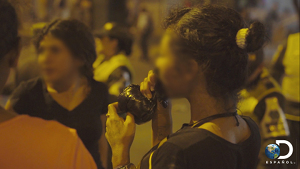
A scene from El Mercado de la Inocencia
Photo, video: Discovery en Español
At 10 p.m. E/P this Sunday November 5 Discovery en Español will air for the first time El Mercado de la Inocencia, a one hour Spanish language documentary (44 minutes of documentary) about sex tourism in Medellin, Colombia, as part of the Discovery a Fondo investigative programming block. The program, often featuring dark scenes filmed with what appear to be hidden cameras, focuses on the former drug trafficking and extreme violence destination now an international capital of sex tourism, including the sale of underage sex. Scroll down to watch a video clip in Spanish.
According to promotional materials, many of the illegal networks run by foreigners in the United States and Europe offer Medellin guided tours with underage prostitutes in their packages available for online purchase. Narrated and directed by David Beriain, a journalist and researcher known for his work on Clandestino’s, the project was headed by Michela Giorelli, Rafael Rodriguez and Carlos Cediel. The program was produced by 93 metros, an independent Spaniard production company, earlier this year and required six months to produce. A Discovery en Español spokesperson declined to share any information on production costs.
“No, we did another documentary about sex tourism in Cartagena a few years ago,” said Michela Giorelli, vice president, Production and Development Discovery Latam/USH, when asked by email via a publicist if this is the first time the network airs a documentary about sex tourism. “We have also explored the subject with ‘’Trata de mujeres: de Tenancingo a Nueva York’’, an Emmy Award winning documentary about sex trafficking that aired as part of Discovery a Fondo, the networks’s investigative programming block.” When asked if anyone in the film was compensated financially to participate (be video or audio taped or interviewed), she replied, “No, nobody is ever compensated in our investigative documentaries.”
According to the documentary, 24,000 people a day seek sex for sale in Medellin; and more than 90 percent of the sex workers in the city are drug addicted. Government officials and police appear on camera. Street scenes show scantily clad women. In some shots prostitutes with their identities concealed discuss their work and in others sex workers and customers can be seen from a distance. A spokesperson explained that “Most of the cameras were located in such places to protect the identity of interviewees and also to make sure we were getting the “real thing.’’ After November 5, 2017 the documentary should be available on the Go app. Discovery en Español.
Posted by Elena del Valle on July 26, 2017

From Indivisible
Photo, video: Fuse, Kudzu Films
In February 2013, Hilary Linder began work on a project that would lead her to the making of her first film, Indivisible, in which she followed the lives of three undocumented immigrants for almost three years. The 78-minute documentary about three undocumented immigrants, screened in 25 film festivals already, will air on Fuse, a cable network, at 10 p.m. ET July 29, 2017. Scroll down to watch a trailer.

Renata, Evelyn and Antonio meet their relatives at the United States-Mexico border
“Renata, Evelyn, and Antonio were young children when their parents brought them to the U.S. in search of a better life; they were teenagers when their families were deported,” Linder said by email when asked to describe the film. “Today, they are known as Dreamers. Indivisible takes place at a pivotal moment in their lives, as they fight for a pathway to citizenship and a chance to be reunited with their loved ones.”
When asked about the goal of the film, she said: “I selected immigration reform as the focus of my first film because I believe it will shape the identity of the United States for generations to come and because I knew there was an incredible human story to tell. When Congress introduced a comprehensive immigration reform bill in 2013, I grew frustrated that media coverage was focusing on numbers and statistics rather than the actual people at the heart of the debate. Knowing that immigration reform is a highly politicized topic, I set out to make a film that would humanize the issue and that both undocumented and documented audiences could relate to—a film about families.”
In the United States she filmed in Massachusetts, New York City, Florida, and Arizona. Overseas, she filmed in Colombia, Brazil, and Mexico.
The documentary, funded mainly by the filmmaker with $30,000 of support she fundraised online and in person, premiered at the Cinequest Film Festival in March 2016.
”
The most common reaction is that they had no idea that families were being separated by deportation or what it is like for families to be separated, and, now that they know, they want to do something to change our immigration system and prevent this from happening,” Linder said when asked about people’s reaction to the film. “Before the election, many people indicated that the film had changed their mind about who they would vote for. And today, at such a scary time for immigrants in the U.S., audiences overwhelmingly ask what they can do to help. We like to direct people to our Take Action page on our website (indivisiblefilm.com/takeaction), where they can sign petitions, receive information about contacting their Members of Congress, and sign up to host their own screening of Indivisible.”
Posted by Elena del Valle on May 25, 2017

The Business of Recovery
Photos, video: The Business of Recovery
It took the filmmakers behind The Business of Recovery (thebusinessofrecovery.com/) four years to complete the 81-minute documentary targeting “The overwhelming number of people who have been affected by addiction…directly or indirectly.” In June of 2016, they released the film to the public via iTunes, Amazon and Google Play. It was recently screened at the Palm Beach Film Festival. Scroll down to watch a trailer of the film.
According to the Center for Disease Control, in 2015 some 88,000 people in the United States died of alcohol abuse and 47,000 died of a drug overdose. Every day 6,300 people seek addiction treatment at 14,000 treatment centers across the nation; and addiction treatment revenue has increased from $9 billion in 1986 to $34 billion in 2016 while drug overdose rates have tripled, according to The Business of Recovery.
Ninety percent of the centers base their treatments on Alcoholics Anonymous Twelve Steps principles despite abysmal rates of recidivism, according to the documentary. A spokesperson for the National Institute on Drug Abuse explains on camera that there is only anecdotal evidence of limited success for Alcoholics Anonymous treatment. At the same time, there are 60,000 sober living homes across the country with little or no regulation.
“Our goal in making The Business of Recovery was to demand the addiction treatment industry change the way addiction is treated in three primary areas: Better educated and medically licensed professionals in charge of addiction treatment, Regulations to protect the patient and align addiction treatment facilities with medical standards, the use of scientifically proven treatments (empirical, not evidence based),” said Greg Horvath, producer of the film, by email.
He and a close friend financed the documentary, which cost less than one million dollars to make. The producers spoke to hundreds of people, interviewed over 60 families, addiction experts, treatment providers, doctors, and scientists from across the United States.
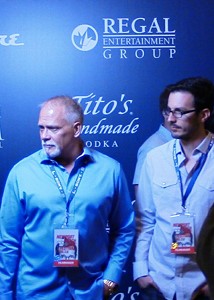
Greg Horvath, producer, and Adam Finberg, director, The Business of Recovery at the Newport Beach Film Festival
“The toughest challenge was assembling the enormous amount of information we gathered and create a film that would help educate people that for as ‘medical’ as the addiction treatment industry sounds and acts, it lacks most if not all of the rigors of science that are applied to medical treatments,” Horvath said when asked about the greatest challenge and biggest reward of the film project. “And it is all but absent of regulations to protect the patient and align addiction treatment facilities with medical standards. The greatest reward has been the ground swell of public support the film has received, and to see some aspects of the industry slowly starting to change.”
When asked what marketing strategies they had used to promote the film he said, “Our strategy was to create public interest in the film thru film festivals and other screenings. The Business of Recovery premiered at the Newport Beach Film Festival to three sold-out audiences and has been screened across the United States (and Canada) to many other sold-out audiences at film festivals, prestigious post-secondary institutions (including Columbia University Medical School in NY, UC Irvine School of Medicine and School of Law in CA, and Spalding University, School of Professional Psychology in KY, to name a few), and many other public and private screenings. As well, it was one of only four films invited to screen at the International Drug Policy Reform Conference in Washington, DC.”
Click to buy The Business of Recovery
Posted by Elena del Valle on April 3, 2017
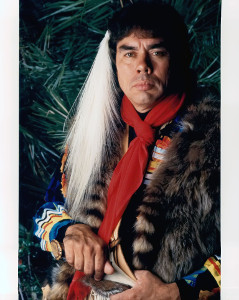
James E. Billie
Photo: Peter Gallagher
Video: Wrestling Alligators, Inc.
James E. Billie was born an outcast in the Florida swamps and grew from poverty to become chairman of the Seminole Tribe of Florida and the most influential man in his tribe. Some might say he is the most influential Native American leader in the past 100 years. Under his leadership the Seminole Tribe became wealthy from reservation gambling on its Florida land. Wrestling Alligators The New Seminole Wars, a 90-minute documentary completed in 2016, shines a bright light on Billie’s life, showcasing via vintage news clips, photos, and interviews how he became an alligator wrestler, war veteran, poet, and important leader of the Seminole Tribe of Florida. The film was shown at the Palm Beach Film last week and should be available in digital format soon. Scroll down to watch a video clip from the documentary.
Billie controlled a giant gaming organization that owns casinos and businesses all over the world including the Hard Rock Cafes and Casinos brand. Thanks in large part to his efforts, according to the documentary, the Seminole people’s lives were transformed over a 50 year span from living in small huts to being wealthy today. There are between 4,000 and 5,000 Seminoles in the tribe. As a young man Billie wrestled alligators for tourist tips. Later, he enlisted for Vietnam where he served with distinction. After the war, Billie started a chickee hut-building company and became interested in tribal politics. He was elected chairman in the late 1970s. Along the way Billie was nominated for a Grammy that launched his music career.
“We made the film to share James Billie’s and the tribe’s incredible story,” James Eowan, producer of the film, when asked by email about the purpose of the documentary. “This is a story most people have no idea about. Most people don’t know the tribe owns Hard Rock, for instance, and if they do, they have no idea how they got to that point.”
In 1972, Billie started a small high stakes bingo hall in Hollywood, Florida. It was an instant hit, leading to further gaming success, court fights with the state and federal government, and to a wealth not seen until then among Native Americans. He remains a controversial figure inside and outside his tribe, even at 72, according to promotional materials for the film. The tribe kicked him out of office as chairman of the Seminole Tribe for a decade, only to reelect him in 2011.
“We were extremely fortunate in that James Billie and the Seminoles of Florida have been covered by different facets of the media quite extensively over the years,” said Eowan when asked by email what percent of the documentary was from archival footage. “And the tribe also has quite an extensive archive of footage and stills. I would say a good 50 percent of the film is archival and the rest is footage we shot. But we ended up with close to 200 hours of shot footage once we were done.”
The film staff started working on the documentary in December of 2012 and finished it in April of 2016 with a budget of less than one million dollars from independent sources. The producers hope to capture the attention of viewers with a passing interest in Native Americans and that “the film’s quintessentially American story of a man and his people pulling themselves up from their bootstraps will appeal across all audiences.”
Posted by Elena del Valle on March 27, 2017
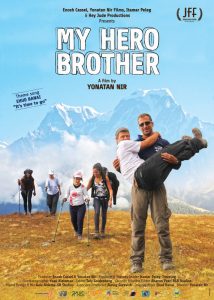
Poster for My Hero Brother
Photo, video: My Hero Brother
My Hero Brother, a heart-warming, 78-minute Israeli film in Hebrew with English subtitles completed June 2016, will be part of the 22 Annual Palm Beach Film Festival (visit pbifilmfest.org/event-calendar) taking place beginning March 29, 2017 in Palm Beach County, Florida. Scroll down to watch a trailer.
Happy and sad at the same time, the film is uplifting and inspiring. Filmed in India with a budget of $306,000 the movie shares the story of a group of remarkable young people with Down syndrome and their siblings who trek through the Indian Himalayas together. Along their journey unresolved conflicts and the complexities of growing up with a Down syndrome child in the family surface.
The idea germinated when Enosh Cassel, later a producer in the film, felt that his busy lifestyle was taking a toll because he wasn’t spending enough time with Hannan, his beloved Down syndrome brother. According to a spokesperson, “In 2011, the two embarked on a challenging trek in the Himalayas, in order to spend some much needed quality time together.” On their return, Cassel received requests from people who wanted to set out on a similar trek with their own Down syndrome sibling. On August 2013, after two years of planning and preparation, a group of 11 sibling couples (“neuro-typical” and Down syndrome) set on a journey to the Indian Himalayas, where My Hero Brother was filmed.
“In the course of the film, I hope that the viewer will undergo an experience that will change his way of looking at the main characters: not as ill-fated people who have been given a chance to experience a brief release from suffering, but rather as human beings blessed with qualities many of us yearn to have, struggling with their limitations in an highly admirable and courageous way, with the ability to open the hearts of those around them and turn them into better human beings,” the director states on the film website.
Yonatan Nir (Dolphin Boy) directed and produced by the film, which according to promotional information became an overnight success. In the first three months of distribution the producers booked 150 educational screenings in Israel, the film was accepted to several international film festivals, and won the Best Documentary Film Award and the Audience Choice Award at the Santa Barbara International Film Festival.
The filmmakers received funding from The Shalem Fund, Gesher Multicultural Film Fund, Mifal Hapais, Avi Chai Fund, and The Second Authority. In addition to the Film festival screening future information on where to view the movie may appear at myherobrother.org
Posted by Elena del Valle on March 22, 2017
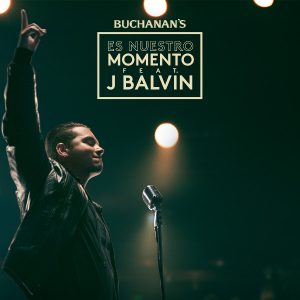
Es Nuestro Momento poster – click image to enlarge
Photo, video: Buchanan’s
Hoping to connect with reggaeton music loving bicultural adult Latinos, 21 and older, who balance two cultures Buchanan’s, a Scottish whisky maker, partnered with SoundCloud to offer them the Es Nuestro Momento Feat. J Balvin contest campaign and competition. The contest ran March 6-20, 2017. The prize was a trip to the 2017 Latin Billboards in Miami and a chance to meet J Balvin in person. It included a microsite where participants could watch the Es Nuestro Momento video with Balvin singing a capella vocals of a new and unreleased track by the same name. To enter the contest, they were required to create their own version of the song including Balvin, and upload their version to the website for people to vote for their favorite version by April 7. Balvin will select the winner and announce his or her name via his Facebook page April 19. Scroll down to watch an Es Nuestro Momento campaign ad.
The contest was a segment of Buchanan’s integrated marketing campaign, which was promoted through out-of-home advertising, television spots, digital ads with dedicated responsible drinking creative, social media and experiential, in addition to this consumer contest. According to a spokesperson, the contest was “being amplified through PR, digital, social, and paid integrations including Nylon En Espanol, Telemundo, and Billboard.”
Balvin’s song, inspired by the brand’s recent 360 Es Nuestro Momento marketing campaign, was designed to celebrate the Latino community and its positive influence on American mainstream culture. A campaign spokesperson did not respond to a question about measurement of the contest results. According to a press release, “Through this contest, Buchanan’s aims to inspire people to pursue their passions and celebrate their successes.”
Born in Medellin, Colombia, J Balvin is a Latin-Grammy and Latin Billboard-winning musician. He became the first reggaeton artist to surpass one billion views on YouTube. He has collaborated with artists including Pharrell, Daddy Yankee, and Justin Bieber. SoundCloud is an online audio distribution platform where users may upload, record, promote, and share their original sounds.
Posted by Elena del Valle on March 1, 2017
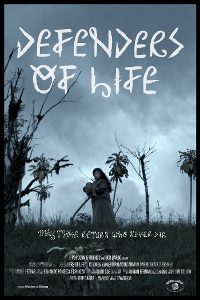
The Defenders of Life poster
Photos by Julio Costantini © 2015 Popcorn & Friends, video clips used with permission © 2015 Popcorn & Friends
In 2015, film director Dana Ziyasheva and her four person team completed Defenders of Life, a 94-minute film in three languages, Ngabere, Spanish, and English, about underage marriage among the Ngäbe people of Costa Rica. Much of the dialogue is in Ngabere or Spanish with English subtitles. It was titled after Defenders of Life, an ancient Ngäbe sacred song celebrating the tribe’s respect for and symbiotic relationship with nature, ancestors and fertility. The film is available exclusively at Flix Premiere, an online video on demand service. Scroll down to watch video clips from the movie with subtitles.
Defenders of Life, a fiction film about real life issues, was born out of the real-life friendship between Carmen, a Ngäbe matriarch, and the director while she was a guest at Carmen’s house. During that time they discussed Carmen’s life and her hopes and fears for her daughters and granddaughters. Much of the film was shot on Ngäbe land and featuring Ngäbe.
“We both wanted to give voice to the voiceless, leaving a proud testimony of her ancient civilization under threat and show the place and challenges of women in this culture,” Ziyasheva said in a press release. “We both wanted it to be aesthetic and allegorical. Carmen’s story is my story too. I was afraid to break away from my society in defiance of the decision-makers of my country. I was equally afraid to leave the comfort and security of the United Nations. It doesn’t matter how good or bad a life situation is, people fear the unknown. To make audiences around the world relate to a story of an indigenous woman lost in a rainforest was my goal as film director in this project.”
Defenders of Life tells the story of Esmeralda, a Ngäbe indigenous girl who lives on a reservation in Costa Rica. Esmeralda’s grandmother Carmen raises her alone because the girl’s mother was murdered by her jealous boyfriend. In the movie, as in real life, when a Ngäbe girl reaches puberty, she becomes eligible for marriage, as is the custom of the tribe. When the village elder asks for her hand in marriage, Carmen must decide whether Esmeralda should follow in the footsteps of Ngäbe women or break away from the tradition and long term from the community.
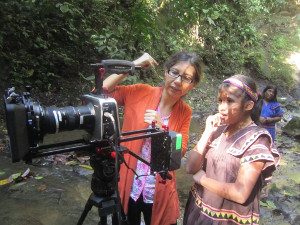
During the filming of Defenders of Life
“We had a script, but since the Ngäbe actors playing their own roles were all non-professionals, most of whom don’t know how to read, we relied a lot on rehearsals and improvisation. I wanted the film to go beyond the ethnographic clichés. We show that Ngäbes are multi-layered, with contradictions, and made of good things and bad things like everyone else. But most of all, they are authentic, true to themselves and they don’t get intimidated by outside pressure,” said Ziyasheva.
In the film, Pamela, an anthropologist from the University of Costa Rica, and her son Feb, an American tween, advocate different approaches to the dilemma of an indigenous people’s society. Through his friendship with Esmeralda, Feb becomes part of tribal dynamic, while well-meaning Pamela aims to force her notion of development on the Ngäbe. Most of the filming took place in the indigenous Ngäbe community of La Casona in Southern Costa Rica, near the border with Panama, and a little bit in San Jose, the Costa Rican capital.
The film, produced by Popcorn & Friends, was recognized with award at Mostra Amazonas de Cinema, Brazil; Burbank International Film Festival, California; Viva! Latino Film Festival NYC Int’l, New York City; Madrid International Film Festival 2016; Love International Children Film Festival, California; International Film Festival for Peace, Inspiration and Equality, Indonesia; Global Independent Film Awards, online; and Depth of Field International Film Festival, online.
“To make this crazy guerilla-style project possible, I was lucky to assemble a unique international team of passionate film professionals from France, Brazil, Cuba and Costa Rica. They were all 100 percent dedicated to the idea of living and working with the Ngäbe in the rain forest in order to make this film, no matter the hardships, budget constraints or physical risks,” said Igor Darbo, producer, by email via the film’s publicist. “Snakes were never too far, both in the story and on set! Of course it also took time to gain the Ngabe’s trust, especially the men’s and after visiting the community multiple times and taking part in their festivals and assemblies, I develop a bond with Don Francisco, the elder leader who then agreed to play the old man marrying the teenage girl in the film. That bond was the mirror of Dana’s relationship with Dona Carmen, the protagonist and that’s what made the film possible. As a producer, I am extremely proud that Defenders of Life was able to touch the heart of people on all continents, but most of all of the enthusiastic reception it got from the Ngäbe themselves.”
Ziyasheva is an award-winning author, scriptwriter and film director from Kazakhstan. She has 25 years of field experience as a journalist. As adviser for Communication and Information of the United Nations she has traveled from Iraq to China and Central America. In 2016, her debut novel Shock was published in France.
Popcorn & Friends is a boutique production company founded in March 2012 by Darbo to produce “highly creative international films that are both entertaining and meaningful.” After winning the Best Co-Production Project award at the Shanghai International Film Festival for its high-concept Chinese treasure hunt The Dragon Angel, Popcorn & Friends produced Defenders of Life.
Between 200,000 and 250,000 Ngäbe people live on both sides of the border between Panama and Costa Rica. The community in the film is about 1,500 people large in Southern Costa Rica. According to the film producers, the Ngäbe (Ngabere is their language) are torn between tradition and assimilation into the modern society. Their youth start to slowly lose command of their native idioms and follow traditions less while education in Spanish and work opportunities in the city draw them further away from their ancient roots.
The proposal
The snakewoman






















